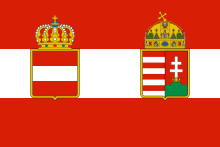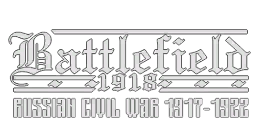
The Austro-Hungarian Empire was one of the Central Powers in World War I. It was union consisting of the two monarchies Austria and Hungary of equal status, the regent was both emperor of Austria and King of Hungary and both countries had their own institutions from parliament to military. The Dual-Monarchy also had control over other states. These states include the kingdom of Croatia-Slavonia and Bosnia and Herzegovina.
Austria-Hungary initiated the war in 1914 after declaring war on Serbia, forcing its ally Russia to intervene and invade Galicia. This in turn, led to other nations also participating through treaty obligations. The Serbian campaign was a disaster at first for Austria-Hungary, by the end of 1914 they had suffered defeats at Cer, Kolubara and Suvobor, and had failed to secure any Serbian territory. In the following year first Belgrade, then the rest of Serbia would be conquered by the combined might of the central powers, which by then included the Kingdom of Bulgaria. On the eastern front with Russia, they faced the defeat at the fortress of Przemysl, the longest siege during the entire war.
The Austro-Hungarian was further strained when Italy declared war, which opened up the Italian front throughout the rest of the war. This front ran from the mighty alps at Paternkofel and Passo di Falzarego through to the Isonzo river. Meanwhile to the east, they would suffer a major blow at the hands of the Russian Brusilov Offensive, and would increasingly rely on their German ally throughout the rest of the war to remain in the fight. One hope for a victorious outcome would arrive in late 1917 when the deadlock of the Isonzo front was succesfully broken with German assistance at Tolmezzo, and the Italian army was pushed back to the Piave River. This however was not to last, and the Imperial army would only offer increasingly anemic actions until a final defeat at Vittorio Veneto in late 1918 would shatter the morale of the Austro-Hungarian forces, as well as the very fabric of the empire.
The Austro-Hungarian Empire was de facto dissolved by the time the military authorities signed an armistice at Villa Giusti on 3 November 1918. With the dissolution Austria and Hungary both appeared as smaller independent states and new states like the West Ukrainian People's Republic emerged.
Austro-Hungarian soldiers of BF1918 speak an Austrian dialect of German. There are a number of different troops but the common uniform is dark blue with a matching field cap, Bosnian troops are distinguished by the Fez they wear. In the cavalry battle at Jaroslawice some of the troops wear uniforms of the Royal Dragoons. The Austro-Hungarian military followed the German army by first buying German steel helmet and then starting production of a very similar steel helmet in the middle of the war. They were painted in a distinctive brown colour.
Equipment[]
See Equipment of the Austro-Hungarian Empire



